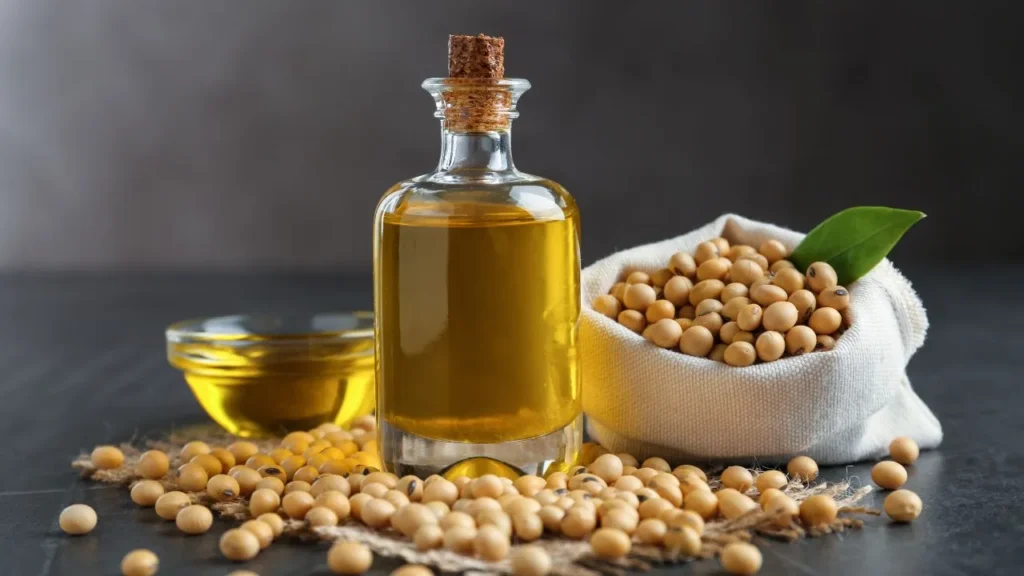Soybean oil is a versatile choice for frying, with a high smoke point of 450°F, making it ideal for high-heat cooking. Its neutral flavor allows the natural taste of ingredients to shine, ensuring fried food retains its authentic flavor.
Soybean oil is also rich in polyunsaturated fats, which support heart health and may lower the risk of heart disease when used instead of saturated fats.
In this article, we’ll explore the benefits of soybean oil for frying, its composition, and how it compares to other frying oils to help you make informed choices.
Overview of Frying as a Cooking Method

Frying involves cooking food in hot oil. It requires oils that can handle high temperatures without breaking down. The best frying oil should have a high smoke point to prevent harmful compounds.
The Popularity of Soybean Oil
Soybean oil is a top choice for frying with a smoke point of 450°F (232°C). This high heat tolerance makes it ideal for various frying techniques. Its versatility has made it a kitchen staple in many homes.
The fatty acids in soybean oil contribute to its popularity. Each tablespoon contains:
- 1g of saturated fat
- 3g of monounsaturated fat
- 7g of polyunsaturated fat (including omega-3 and omega-6)
These fatty acids add flavor and may offer health benefits. Studies suggest omega-6 fats might help lower cholesterol and blood sugar levels. This could potentially reduce heart disease risk.
Soybean oil’s rise to fame is remarkable. In 1966, it became the world’s leading edible oil. By 1942, the US was the top producer globally.
Today, US-grown soybean oil has the lowest carbon footprint compared to other sources. This makes it an eco-friendly choice for frying.
What is Soybean Oil?

Soybean oil is a top choice in American kitchens. It comes from soybeans, the leading U.S. crop. The U.S. produces one-third of the world’s soybeans.
This oil’s popularity stems from its many uses and health perks. It’s a versatile option for cooking and baking.
Soybean Oil Production Process
Making soybean oil involves several steps. First, soybeans are cleaned, cracked, and hulled. The beans are then flattened into flakes.
Oil is extracted from these flakes using a solvent. Lastly, the oil is refined, bleached, and deodorized for cooking use.
Nutritional Profile of Soybean Oil
Soybean oil is packed with omega-3 fatty acids, making it heart-healthy. It’s also free of trans fats, which helps manage cholesterol levels.
- 13.6 grams of total fat
- 2.12 grams of saturated fat
- 3.1 grams of monounsaturated fat
- 7.85 grams of polyunsaturated fat
This oil provides vitamins E and K. One tablespoon contains 1.11 mg of vitamin E and 25 mcg of vitamin K.
These nutrients boost skin health and help blood clot. While beneficial, use soybean oil in moderation as part of a balanced diet.
Benefits of Using Soybean Oil for Frying

Soybean oil is a versatile cooking oil for frying. It has unique properties that make it great for home cooks and chefs. Let’s look at the main benefits of using soybean oil for frying.
High Smoking Point
Soybean oil has a high smoke point of 450-464°F (230-240°C). This means it can handle high heat without breaking down or smoking. You can fry foods at perfect temperatures for crispy outsides and well-cooked insides.
Neutral Flavor
Soybean oil’s neutral taste is a big plus for frying. It doesn’t mask the natural flavors of your ingredients. This makes it great for many types of cuisine.
Cost-Effectiveness
Soybean oil is a budget-friendly choice for several reasons:
- Widespread availability due to large-scale production
- Extended frying lifespan compared to conventional oils
- Ability to be reused multiple times when properly strained and stored
These factors make soybean oil cheap for homes and restaurants. Its long shelf life helps reduce waste and the need to buy new oil often.
Health Considerations

Soybean oil is popular for healthy frying due to its unique nutritional profile. It comes from soybeans, a sustainable crop with various health benefits. Cooking with soybean oil can be good for you.
Fatty Acid Composition
Soybean oil contains lots of polyunsaturated fats, including omega-3 fatty acids. These fats are essential for heart health. Studies show that using more polyunsaturated fats can lower heart disease risk.
Impact on Cholesterol Levels
Research shows soybean oil can improve lipid profiles. A study found that high-oleic soybean oil led to better results than palm oil. Using soybean oil for cooking may help manage cholesterol levels.
Vitamin Content
Soybean oil is the main source of vitamin E in the U.S. diet. It contains different forms of tocopherols, with gamma-tocopherol being the most abundant. Vitamin E acts as an antioxidant, supporting skin health and overall well-being.
- Alpha-tocopherol: 8.18
- Beta-tocopherol: 0.90
- Gamma-tocopherol: 64.26
- Delta-tocopherol: 21.30
Soybean oil offers many health benefits, but balanced consumption is key. It has more omega-6 than omega-3, which in excess may cause inflammation. Using a variety of healthy fats in your diet ensures optimal nutrition.
Cooking with Soybean Oil

Soybean oil is top-notch for cooking, especially frying. Its high smoke point of 256°C makes it ideal for deep-frying. It won’t break down or create harmful compounds.
Best Practices for Frying
Here are some tips for using soybean oil in frying:
- Maintain oil temperature between 350°F and 375°F for optimal results
- Use a thermometer to monitor oil temperature and avoid overheating
- Pat foods dry before frying to reduce splattering and ensure crispy results
Temperature Control
Soybean oil’s smoke point is 450-464°F. This high-temperature tolerance makes it great for various cooking methods. It’s perfect for deep-frying and stir-frying.
Food Preparation Tips
Get the most out of soybean oil:
- Use it for baking, roasting, and as a base for salad dressings
- Remember, it’s cholesterol-free and high in polyunsaturated fats
- Consider its high digestibility for those intolerant to other oils
Soybean oil is versatile and works well in savory and sweet dishes. It’s rich in omega-3 and omega-6 fatty acids. This makes it a smart choice for heart-healthy cooking.
Comparing Soybean Oil to Other Frying Oils
Choosing the right frying oil involves considering the smoke point and flavor profile. Soybean oil shines with its high smoke point and neutral flavor. It’s a versatile option for various cooking methods.
Soybean Oil vs. Canola Oil
Soybean oil’s smoke point (256°C) surpasses canola oil’s (204°C). This makes soybean oil ideal for deep-frying. Canola oil contains 25% linoleic acid, while soybean oil typically has less.
Soybean Oil vs. Olive Oil
Extra light olive oil’s smoke point (242°C) is slightly lower than soybean oil’s. Olive oil offers distinct flavors, while soybean oil remains neutral. Soybean oil’s versatility makes it suitable for various cuisines.
Soybean Oil vs. Sunflower Oil
Sunflower oil’s smoke point (227°C) is lower than soybean oil’s. Both oils work well for daily cooking and frying. Soybean oil is often more cost-effective, making it popular in commercial kitchens.
A recent study showed that high oleic soybean oil outperformed 75% oleic canola oil. After extended frying, the total polar material (TPM) and polymerization were lower. This suggests soybean oil maintains quality longer than other options.
Soybean oil may require less frequent changes in commercial settings. This makes it an efficient choice for large-scale frying operations.
Conclusion
Soybean oil shines as a top frying option. Its high smoke point and neutral flavor make it perfect for various cooking needs. Both home cooks and chefs can rely on this versatile oil.
Summary of Soybean Oil’s Benefits for Frying
Soybean oil’s makeup is ideal for healthy frying. It’s rich in omega-3 and omega-6 fatty acids, which boost heart and brain health. Its high smoke point keeps food flavorful and preserves the oil’s nutrients.
Final Thoughts on Choosing Soybean Oil
Soybean oil stands out among frying oils. It’s affordable, easy to find, and offers potential health perks. The FDA says 1½ tablespoons daily may lower heart disease risk.
Its mild taste works well in many dishes. This makes it great for frying and other cooking methods.
Soybean oil balances nutrition, function, and cost-effectively. It’s a smart choice for health-conscious cooks. This oil delivers consistent results in frying, sautéing, and baking.
FAQ
Is soybean oil good to fry in?
Soybean oil is low in saturated fat and high in unsaturated fats. Its high smoke point (256 °C) and inexpensive price make it ideal for deep-frying. Although sesame oil is also low in saturated fat, it is primarily used as a flavor enhancer rather than cooking oil. For more details, see soybean oil benefits.
What is the downside of soybean oil?
A study in mice demonstrated that a diet high in soybean oil led to adverse metabolic changes, including increased body fat, high blood sugar, and fatty liver, compared to diets high in coconut oil or fructose, a type of sugar. For more insights, refer to the effects of soybean oil.
Which is the best oil for frying?
Canola oil, a golden-yellow oil made from the canola (rapeseed) plant, has a neutral flavor and a high smoke point of 468°F, making it an excellent choice for frying. To learn more, visit this canola oil overview. Learn more here: Best Oil for a Fryer – Discover the Top Choice for Frying.
Is soybean oil better than canola oil?
Canola and soybean oil are nutritionally similar, providing roughly the same calories per gram, and both are good sources of vitamins E and K. Additionally, both contain omega-3 and omega-6 fatty acids. For a detailed comparison, check this canola vs. soybean oil analysis.
What are the benefits of using soybean oil for frying?
Soybean oil is an excellent choice for frying due to its high smoke point, which allows it to withstand high temperatures without breaking down. This makes it ideal for producing crisp and evenly cooked dishes. Rich in polyunsaturated fats, including omega-3 and omega-6 fatty acids, soybean oil also offers heart health benefits. It is also a versatile and affordable option that is popular in home and commercial kitchens.






